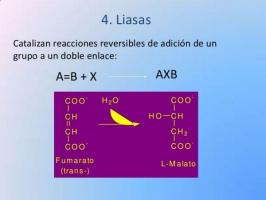What is an ENZYME and its function

Although they are generally very unknown, enzymes are proteins that are present in your day to day. As we'll see during this TEACHER lesson, enzymes are proteins found in food, in soil, and even inside of us! Next we will discover you what is an enzyme and its function so that you know better these proteins so important for human life. Attentive!
Index
- What is an enzyme?
- Enzyme function
- The Importance of Enzymes: Examples of Enzymes
What is an enzyme?
Enzymes are, in general, a type of protein. Remember that proteins are large molecules, made up of amino acids, that is, thanks to the action of DNA. Enzymes are normally proteins, but some very specific types of RNA they can also have enzymatic function.
We can find enzymes both in living beings and in non-living systems, since there are a great variety of enzymes that can live in different conditions and be involved in different chemical reactions. As we will see later, we can find enzymes in fruits or in the soil, but also our own body.

Image: Slideplayer
Function of enzymes.
An enzyme is a biological catalyst, that is, it is a protein that accelerates or facilitates the speed of a specific chemical reaction. The greatest advantage of enzymes is that they are not destroyed during the reaction and therefore can be used over and over again until they are degraded.
Another of the greatest advantages of enzymes is their great variety and the low energy What is necessary to form them: a cell contains thousands of different types of specific enzyme molecules for each specific chemical reaction that occurs inside it. There are enzymes that cut DNA, there are enzymes that stick DNA, there are enzymes in charge of cutting other proteins, or adding or eliminating other molecules to them. Normally they are molecules that need little energy to do their job, but they do require very controlled chemical conditions (temperature, pH, concentration of other substances, etc.).
A very important aspect of enzymes is their specificity. Each enzyme is capable of facilitating or accelerating the interaction or breakdown of a certain set or molecule, but not of others. The enzyme responsible for the breakdown of lactose will not be able to facilitate the breakdown of starch and vice versa. Enzyme specificity can be seen as both an advantage and a disadvantage: on the one hand, it gives us the advantage of ensuring that only a certain chemical reaction will take place; on the other, we will need to produce a different enzyme for each reaction that we want to carry out, in addition to coordinating their actions, their production, and when and where each one of them works.
We have previously talked about the enzymatic function of RNA. The goal of a chemical catalyst is to increase the rate at which a reaction occurs, and this is exactly what RNA does: some microorganisms or viruses are capable of greatly facilitating the splicing of itself, to be very effective when it comes to "parasitizing" others cells.
The importance of enzymes: Examples of enzymes.
Enzymes are not just other molecules, but they are very important. In a natural way, enzymes help to carry out a large number of chemical reactions within us. Here are some examples of enzymes, with important functions:
- Amylases. The different types of amylase, produced in the mouth, help break down large starch molecules into smaller sugar molecules.
- Pancreatic lipase. This enzyme is produced in the pancreas and is used to break down fats.
- Ribonuclease and deoxyribonuclease. These two types of enzymes are produced in the pancreas and their function is to break chains in nucleic acids such as DNA and RNA, to recycle them and reuse them or to dispose of them.
- Lactase. Lactase is an enzyme produced in the small intestine and synthesized during the infancy of all mammals. Its absence produces lactose intolerance.
Enzymes can also be found in food that we ingest, and they have different functions:
- Papain. Papain, which is found in papaya, works by breaking down proteins into amino acids, so it not only helps with poor digestion but is also widely used in products cosmetics for having antiseptic and anti-inflammatory properties in skin conditions, helping to reduce mycoses (fungal infections) and is a powerful antioxidant, among other.
- The enzymes in honey. Honey contains diastase, invertase, glucose oxidase, catalase and acid phosphatase, all of which are enzymes that help improve digestion, but also have other properties used in the cosmetic and food industry among other
Enzymes are also very important in different industries. Enzymes have been used in industry since time immemorial, even before their discovery. Some of the most used currently are:
- Glucose isomerase. Used to obtain high fructose syrups from cornstarch.
- Penicillin G acylase. Used for the production of semisynthetic penicillin precursors, which form antibiotics.
Soil, especially cultivated soil, also has a large amount of enzymes. Some of the most important are phosphatase, β-Glucosidase, dehydrogenase and urease, which could be used as a biomarker, to report the quality of cultivation soils.
If you want to read more articles similar to What is an enzyme and its function, we recommend that you enter our category of biology.
Bibliography
- Ramírez, Joaquín & Ayala Aceves, Marcela. (November 1, 2014) Enzymes: what are they and how do they work? "Revista Digital Universitaria [online]. Recovered from: http://www.revista.unam.mx/vol.15/num12/art91/index.html. ISSN: 1607-6079.
- P. Austin, Christopher (s.f) Enzyme. NHGRI. Recovered from: https://www.genome.gov/es/genetics-glossary/Enzima
- Alegria, M. AND. R., & Rosales, E. C. (2014). Enzymes applied in industrial processes. University Digital Magazine.
- Henríquez, C., Uribe, L., Valenciano, A., & Nogales, R. (2014). Soil enzymatic activity-dehydrogenase, β-glucosidase, phosphatase and urease-under different crops. Costa Rican Agronomy, 38 (1), 43-54.
- Pérez del Pozo, Paloma (s.f) Enzymes in food: what they are and what they are for. Recovered from: https://www.alimentatubienestar.es/las-enzimas-en-los-alimentos-que-son-y-para-que-sirven/
- Cech, T. R. (1987). RNA enzymatic function. Research and Science, 124, 42-51.


